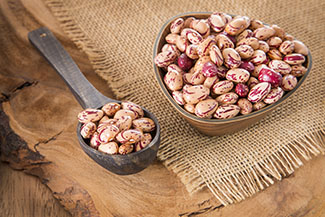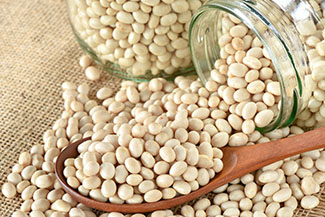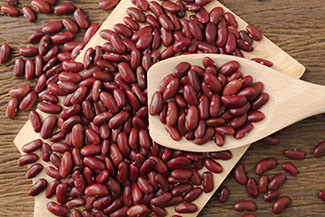Farm Fresh Beans
Eat More Beans!
Beans are high in protein, have virtually no fat and have more fiber than most whole-grain foods. U.S. dietary guidelines says that diets including beans may reduce your risk of heart disease and certain cancers. And, no one grows our pinto, and other dried beans, better than our Arizona bean farmers.
In Arizona, while dry beans were dropped from our annual estimating program after 2015 by the United States Department of Agriculture (USDA), at that time Arizona acreage was around 10,000 acres (including chickpeas). Pinto beans accounted for 4,000 of those acres.
But, in the latest Census of Agriculture (2017) released this year, Arizona's dry-bean harvest was 5,177 acres in 2017 and 90% of these acres were in Cochise (2,572) and Graham (2,083) counties. These two counties produced 93% of the state's dry-bean production.
So, while we might not be the king of dried-bean agriculture production arena (see the facts below for the top 10 U.S. states), we can at least say we grow the musical fruit. Too me that's magical.

Arizona Farm BureauArizona Farm Bureau joined Rosie on the House this summer to discuss our bean production in the state.
Fun Facts About #Beans
- January 6th is National Bean Day.
- National "Eat Beans Day" is July 3rd.
- The top five beans grown in the United States are pinto beans, navy beans, black beans, red kidney beans and great northern beans.
- Beans have been cultivated by humans for 6,000 years.
- Dry pinto beans are one of the most cost-efficient forms of protein at 7 cents per half-cup serving. Lean ground beef is $1.18 per 4-oz. serving and chicken is 82 cents per-4 oz. serving. Eggs are a very healthy and economical protein too!
- The USDA recommends that adults eat more than three cups of beans each week for maximum health benefits, three times more than the current average American consumes.
- Approximately 71,089 people in the world have the last name Bean.
- Vermont ranks highest in searching for bean recipes online. Montana and Wyoming are second and third.
- In ancient Greece, minor public officials were elected by drawing beans. The person who got the white bean got the job.
- The Alabama Butterbean Festival set the record for the largest pot of baked beans at 1,010 gallons.
- North Dakota has retained its position as the top-ranking producer of dry edible beans in the United States since 1991.
- Every hour, 38.5 tons of baked beans are eaten in Britain.
- In Nicaragua, newlyweds are given a bowl of beans for good luck.
- In the 1980s an archaeologist working in New Mexico came upon a clay pot sealed with pine tar containing bean seeds that were 1,500 years old...and they grew!
- Beans can be made into burgers, cakes, drinks, pies, fudge, muffins, jewelry, furniture (bean-bag chairs!), toys, and musical instruments.
 The world's largest bean pods can grow up to 5 feet long.
The world's largest bean pods can grow up to 5 feet long.- Beans are one of nature's healthiest foods, they are naturally low in total fat, contain no
- saturated fat or cholesterol, and provide important nutrients such as fiber, protein, calcium, iron, folic acid and potassium.
- National and international expert bodies, including the National Research Council, the World Health Organization, the World Cancer Relief Fund, the National Heart, Lung, and Blood Institute, and the U.S. Surgeon General, have reviewed scientific evidence and concluded that eating beans can be an important ally in maintaining health and may reduce the risk of heart disease and certain cancers. Other studies suggest beans are useful in managing diabetes, may cut risk for high blood pressure and may help in losing weight.
New Bean Dietary Guidance
The new bean dietary guidance message applies to more than a dozen types of dry beans (both dry-packaged and canned varieties), including:
- Black-eyed
- Great Northern
- Pinto
- Kidney
- Black
- Cranberry
- Red
- Lima's and Baby Lima's
- Garbanzo
- Navy
The Top U.S. Bean-Growing States

Data based on 2004 estimates
- North Dakota (475,000 acres)
- Michigan (185,000 acres)
- Nebraska (110,000 acres)
- Minnesota (100,000 acres)
- Idaho (78,000 acres)
- Colorado (67,000 acres)
- California (65,000 acres)
- Washington (29,000 acres)
- Wyoming (24,500 acres)
- Texas (17,500 acres)
While we don't rank in the "top 10" for bean production, our favorite local beans come from Bonita Bean Company in Willcox, Arizona. Processing local beans since 1997, look them up and visit. And, make sure you take home a bag of their pinto beans grown by Arizona bean farmers.
Want some bean-based recipes or looking to learn how to grow your own beans in Arizona's climate?
Go to FillYourPlate.org, Arizona Farm Bureau's website full of blog stories about health and nutrition and gardening. Most of our recipes are provided by Arizona's own farm and ranch families.
PODCAST: Outdoor Living Hour! Talking Tomatoes With Arizona Farm Bureau
Julie of the Arizona Farm Bureau and the Arizona Department Of Agriculture Director Mark Killian discuss growing tomatoes in Arizona. Why they are designated as a fruit, nutritional value and how to grow your own.
Content Provided By: Julie Murphree, Arizona Farm Bureau Outreach Director
